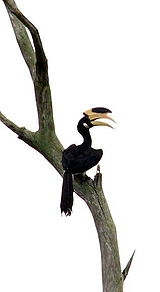
Malabar Pied Hornbill
Encyclopedia
The Malabar Pied Hornbill (Anthracoceros coronatus) is a hornbill
. Hornbills are a family of tropical near-passerine bird
s found in the Old World
.
The Malabar Pied Hornbill is a common resident breeder in tropical southern Asia
from India
and Sri Lanka
east to Borneo
. Its habitat is open woodland and cultivation, often close to habitation.
During incubation, the female lays two or three white eggs in a tree hole, which is blocked off with a cement made of mud, droppings and fruit pulp. There is only one narrow aperture, just big enough for the male to transfer food to the mother and the chicks.
When the chicks have grown too large for the mother to fit in the nest with them, the mother breaks out and rebuilds the wall, after which both parents feed the chicks.
The Malabar Pied Hornbill is a large hornbill, at 65 cm in length. It has mainly black plumage apart from its white belly, throat patch, tail sides and trailing edge to the wings. The bill is yellow with a large, mainly black casque. Sexes are similar, but immatures have a smaller casque.
This species is omnivorous, taking fruit, fish and small mammals. Figs form an important part of their diet and contribute to 60% of their diet from May to February, the non-breeding season and during breeding (March to April) up to 75% of the fruits delivered at the nest were figs. They also feed on other fruits including those of the Strychnos nux-vomica that are known to be toxic to many vertebrates.
In central India, tribals believed that hanging a skull of the hornbill (known as dhanchidiya) brought wealth.
Hornbill
Hornbills are a family of bird found in tropical and subtropical Africa, Asia and Melanesia. They are characterized by a long, down-curved bill which is frequently brightly-colored and sometimes has a casque on the upper mandible. Both the common English and the scientific name of the family...
. Hornbills are a family of tropical near-passerine bird
Bird
Birds are feathered, winged, bipedal, endothermic , egg-laying, vertebrate animals. Around 10,000 living species and 188 families makes them the most speciose class of tetrapod vertebrates. They inhabit ecosystems across the globe, from the Arctic to the Antarctic. Extant birds range in size from...
s found in the Old World
Old World
The Old World consists of those parts of the world known to classical antiquity and the European Middle Ages. It is used in the context of, and contrast with, the "New World" ....
.
The Malabar Pied Hornbill is a common resident breeder in tropical southern Asia
Asia
Asia is the world's largest and most populous continent, located primarily in the eastern and northern hemispheres. It covers 8.7% of the Earth's total surface area and with approximately 3.879 billion people, it hosts 60% of the world's current human population...
from India
India
India , officially the Republic of India , is a country in South Asia. It is the seventh-largest country by geographical area, the second-most populous country with over 1.2 billion people, and the most populous democracy in the world...
and Sri Lanka
Sri Lanka
Sri Lanka, officially the Democratic Socialist Republic of Sri Lanka is a country off the southern coast of the Indian subcontinent. Known until 1972 as Ceylon , Sri Lanka is an island surrounded by the Indian Ocean, the Gulf of Mannar and the Palk Strait, and lies in the vicinity of India and the...
east to Borneo
Borneo
Borneo is the third largest island in the world and is located north of Java Island, Indonesia, at the geographic centre of Maritime Southeast Asia....
. Its habitat is open woodland and cultivation, often close to habitation.
During incubation, the female lays two or three white eggs in a tree hole, which is blocked off with a cement made of mud, droppings and fruit pulp. There is only one narrow aperture, just big enough for the male to transfer food to the mother and the chicks.
When the chicks have grown too large for the mother to fit in the nest with them, the mother breaks out and rebuilds the wall, after which both parents feed the chicks.
The Malabar Pied Hornbill is a large hornbill, at 65 cm in length. It has mainly black plumage apart from its white belly, throat patch, tail sides and trailing edge to the wings. The bill is yellow with a large, mainly black casque. Sexes are similar, but immatures have a smaller casque.
This species is omnivorous, taking fruit, fish and small mammals. Figs form an important part of their diet and contribute to 60% of their diet from May to February, the non-breeding season and during breeding (March to April) up to 75% of the fruits delivered at the nest were figs. They also feed on other fruits including those of the Strychnos nux-vomica that are known to be toxic to many vertebrates.
In central India, tribals believed that hanging a skull of the hornbill (known as dhanchidiya) brought wealth.
External links
- Oiseaux Photo

